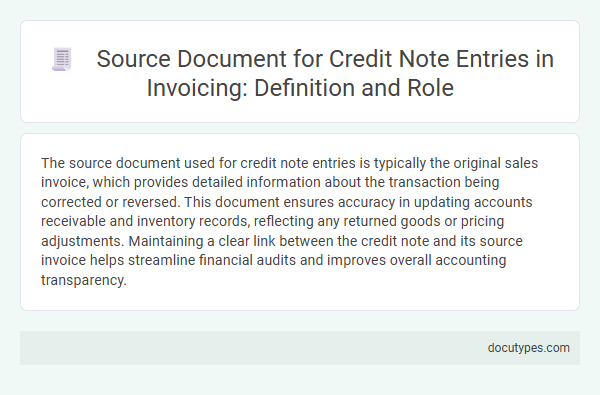The source document used for credit note entries is typically the original sales invoice, which provides detailed information about the transaction being corrected or reversed. This document ensures accuracy in updating accounts receivable and inventory records, reflecting any returned goods or pricing adjustments. Maintaining a clear link between the credit note and its source invoice helps streamline financial audits and improves overall accounting transparency.
Introduction to Source Documents in Invoicing
Source documents serve as the original records for all financial transactions, including credit note entries. These documents provide essential evidence to verify and support entries made in your accounting system.
Invoicing relies heavily on source documents to ensure accuracy and traceability of all credit notes issued. Proper use of these documents helps maintain clear records and facilitates audits or financial reviews.
What is a Credit Note?
What is a credit note in accounting?
A credit note is a source document issued by a seller to the buyer, indicating a reduction in the amount payable. It is used to correct invoice errors, reflect returned goods, or provide discounts.
What is the source document used for credit note entries?
The credit note itself serves as the primary source document for credit note entries in accounting. It records the adjustment made to the original invoice, ensuring accurate accounts receivable balances for your business.
Definition of Source Document for Credit Note Entries
The source document used for credit note entries is a formal record that authorizes and validates adjustments to previously issued invoices. It serves as the primary evidence for reducing the amount a customer owes due to returns, discounts, or errors.
This document contains detailed information such as the original invoice number, date, customer details, and the reason for the credit. It ensures accuracy and transparency in financial records and facilitates proper accounting and auditing processes.
Key Elements Found in Credit Note Source Documents
The source document used for credit note entries serves as the official record authorizing adjustments to invoices. It provides essential details for accurate financial tracking and customer account management.
- Credit Note Number - A unique identifier that distinguishes the credit note from other documents.
- Original Invoice Reference - Links the credit note to the specific invoice being corrected or adjusted.
- Reason for Credit - Explains why the credit is issued, such as returns, discounts, or billing errors.
Your proper handling of these key elements ensures transparent and efficient credit note processing within your accounting system.
Types of Source Documents Used for Credit Notes
Source documents used for credit note entries include credit memos, returned goods receipts, and refund vouchers. These documents serve as proof for adjustments to customer accounts, ensuring accurate financial records. Understanding the types of source documents helps you manage credit notes efficiently and maintain transparent transaction histories.
The Importance of Source Documents in Credit Note Processing
Source documents play a crucial role in the accuracy and verification of credit note entries. These documents provide the original evidence needed to justify adjustments made to customer invoices.
- Proof of Transaction - Source documents serve as the official record, confirming the details of the original sale or service that the credit note refers to.
- Audit Trail - They create a clear trail for auditors and accountants to follow, ensuring transparency and compliance in financial reporting.
- Error Correction - Source documents help identify errors or discrepancies in billing, enabling correct and timely issuance of credit notes.
Source Document Workflow for Credit Note Entries
The source document used for credit note entries is typically the original invoice or a specific credit note form issued to adjust or reverse previous charges. It serves as the official record that authorizes the credit transaction in your accounting system.
The source document workflow for credit note entries starts with identifying the invoice requiring adjustment. A credit note is then generated referencing that invoice, specifying the amount and reason for the credit. This document is recorded in the accounting system to update accounts receivable and reflect accurate customer balances.
Legal and Compliance Implications
The source document used for credit note entries is essential in ensuring accurate billing adjustments and maintaining transparent financial records. It plays a critical role in meeting legal and compliance standards by providing verifiable proof of transaction corrections.
- Legal Validation - The source document serves as legal evidence to justify the issuance of the credit note, supporting audit trails and dispute resolution.
- Tax Compliance - It ensures that credit note entries adhere to tax regulations by correctly documenting returns, refunds, or discounts applied.
- Financial Accuracy - The document maintains accounting integrity by linking credit notes to original invoices, preventing revenue misstatements and compliance violations.
Best Practices for Managing Source Documents for Credit Notes
The source document for credit note entries is typically the original invoice or a specific credit note form issued to correct or adjust billing errors. Proper management of these source documents ensures accurate financial records and facilitates audit trails. Maintaining organized and easily accessible credit note documents improves reconciliation and supports compliance with accounting standards, helping you manage your accounts receivable effectively.
What Is the Source Document Used for Credit Note Entries? Infographic

